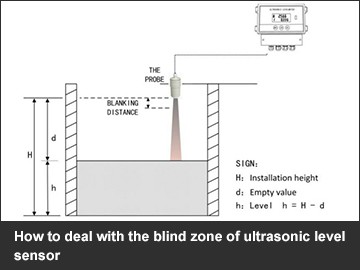How to deal with the blind zone of ultrasonic level sensor
Ultrasonic level sensor is a commonly used measuring tool in industrial production. Because of its wide measurement range, high accuracy, sensitive reaction, and fast response frequency, it is widely used in industrial fields.
Ultrasonic level sensor uses high-frequency pulse sound waves emitted by the ultrasonic transducer (probe) on the device. When it meets the surface of the liquid level (material) to be measured, the transducer converts it into an electrical signal and displays the liquid level data. During the transmission of acoustic pulses, because the mechanical inertia occupies the transmission time, a small area near the ultrasonic transducer cannot receive sound waves, which is called a blind zone. Blind zone is related to the measurement distance of the ultrasonic sensors.
Ultrasonic level senor blind zone is inevitable, but there are a few tricks we can use to reduce the impact of blind spots when measuring.
- 1.First, the blind area is determined by the distance measured by the ultrasound. The smaller the measurement distance, the smaller the blind area; the larger the measurement distance, the larger the blind area. Therefore, in special industrial scenarios, if we need to ensure a small dead zone, we need to consider ultrasonic products with small dead zones, such as an ultrasonic level sensor with a dead zone of 4-6 cm and a measurement distance of 0-1m.
- 2.Because the ultrasonic level sensor cannot recieve reflected pulses at the same time when transmitting ultrasonic pulses. It takes a certain time after the pulse is emitted, and the sensor also has the characteristic of aftershocks. During this period, the reflected echo cannot be detected, so a short distance from the bottom of the probe surface cannot be detected normally. This distance is called a blind zone. If the highest object level enters the blind zone, the instrument cannot detect it correctly and an error will occur. If necessary, raise the level sensor.
- 3.In addition, when installing ultrasonic level sensor, you need to check the blind area of the instrument first, and the installation height must meet: the distance between the highest liquid level surface and the level transducer should be greater than the value of the blind zone.






